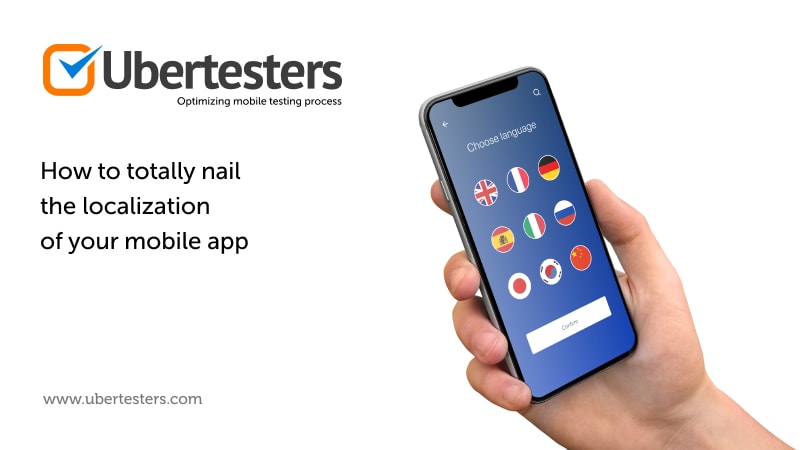How To Totally Nail The Localization Of Your Mobile App

App design would be so easy if you were catering to just one person, wouldn’t it? You could shape each element to their exact preferences, make changes based on their direct feedback, and barely have to put any thought into the process: just A/B test until they’re happy. But you don’t build apps for individuals, you build them for groups — and group members vary.
This is why app developers put a lot of time into testing their designs. They want to get as many opinions as possible (the more the merrier, essentially) to cover as many preferences and perspectives as possible. They can consequently adapt their designs to suit the average user. They won’t be perfect for anyone, but they will be suitable for everyone.
Sometimes a cover-all-the-bases interface isn’t sufficient, though. Standards have changed over the last decade, and mobile users in particular demand localized experiences. They don’t want to be given payment options they can’t use, or news updates that don’t interest them. Ideally, you want the best of both worlds: a design that suits everyone and content that suits the user.
But what’s the best way to approach localization for your mobile app? It certainly isn’t easy, as many businesses have found to their surprise. To help you out, here are some tips for nailing it:
Carry out extensive research
You can’t usefully localize your app if you don’t know anything about the regions you’re aiming to suit. It’s about far more than language — culture plays a huge part, and the more localized content you produce, the more you risk committing a major faux pas that will produce some laughs at best (and possibly sully your reputation).
It’s generally best to consult with at least one native of every region you’re attempting to localize for. You’ll want their feedback not only on the accuracy of the language but also on the potential cultural perception of your copy. Claims that prove impactful in one region will alienate people in another, after all.
Order regions by priority
You’re unlikely to get all your localization done in one fell swoop. It takes time to research and go through all the steps we’ve yet to reach (plus a lot of effort), so it doesn’t even make sense to attempt it. Instead, you should order the localization regions by priority: which country, state, or even city matters the most to you?
This will depend on what’s motivating your localization process. It could be analytics pointing to fresh opportunities for growth based on existing traffic, or a general company-wide commitment to serving a new audience within a developing market. Regardless, whichever region you expect to have the most impact upon your business warrants the top spot.
Run pseudolocalization tests
Pseudolocalization is the process of testing designs using altered strings to see if they can cope with multilingual content. It’s particularly popular in the ecommerce world where there’s a lot of money on the line: for instance, Shopify Plus was designed for global ecommerce, so Shopify created and released this tool for pseudolocalizing strings, making it much easier for merchants to get their stores ready for expansion into other regions.
What you want to avoid is getting all your translations done only to discover that you need to resize various elements of your UI to keep everything in line. 5 words in English might take 9 words in Spanish, so don’t squeeze your text into form-fitting boxes. Leave room for everything to breathe, and design for adaptability.
Set out a style guide
Brand consistency is vitally important, even across languages. Some multilingual users will use different versions of your app at different times, and you don’t want the perception of your brand to be one thing in one region and another thing entirely in others — the fundamental appeal of it should be the same everywhere.
Before you can start reworking and translating your copy, then, you should set out a clear style guide for your brand. At a minimum, it should cover font types, logos, tone, and target audiences (you’ll be addressing the same type of user in every region). Pass that style guide to your translators when you reach that step, and they’ll find it easier to match your brand.
Hire great translators
There are ways to automate translation. You can use free tools like Google Translate to cover the copy, or even find another mobile app to automatically translate your entire app. You shouldn’t, though. You’ll end up with low-quality text that barely makes sense, and your grand expansion will make your brand look distinctly unprofessional.
There’s no way around it: you need to invest in competent translators capable of translating not only the letter of your original text but also the spirit. Basic literal translations often look ridiculous. You can try a freelance service like Gengo and get some samples before committing, or you can bring in some full-time translators — it depends on your budget, of course, but full-time translators will always be preferable.
Or you can try a crowd testing company such as Ubertesters that offers access to thousands of global freelance testers. These test professionals can do the localization testing and translation, but at the same time find other critical bugs on the functionality level.
Keep testing
Your native content will never be perfect, and if you want to keep getting results, you must revise it on an indefinite basis. Your localized content should be no different. If you treat it as less important than your original content and stop paying attention to it, it can easily become outdated — and while it’s live, it will influence how your brand is viewed.
So don’t just test your original content. Test everything: every language you support, and every regional design variant you serve. And never stop testing, because that’s essentially determining that your content is as good as it will ever be — and that’s not an attitude that’s conducive to long-term success.
Localization is hugely valuable in our increasingly-connected world, so if you’re going to do it at all, you need to do it correctly. Follow these steps to ensure that you nail it, and never stop testing — keep reaching towards perfection, even knowing you won’t reach it.

